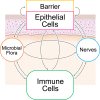Inflammatory loops in the epithelial-immune microenvironment of the skin and skin appendages in chronic inflammatory diseases
- PMID: 37841246
- PMCID: PMC10568311
- DOI: 10.3389/fimmu.2023.1274270
Inflammatory loops in the epithelial-immune microenvironment of the skin and skin appendages in chronic inflammatory diseases
Abstract
The epithelial-immune microenvironment (EIME) of epithelial tissues has five common elements: (1) microbial flora, (2) barrier, (3) epithelial cells, (4) immune cells, and (5) peripheral nerve endings. EIME provides both constant defense and situation-specific protective responses through three-layered mechanisms comprising barriers, innate immunity, and acquired immunity. The skin is one of the largest organs in the host defense system. The interactions between the five EIME elements of the skin protect against external dangers from the environment. This dysregulation can result in the generation of inflammatory loops in chronic inflammatory skin diseases. Here, we propose an understanding of EIME in chronic skin diseases, such as atopic dermatitis, psoriasis, systemic lupus erythematosus, alopecia areata, and acne vulgaris. We discuss the current treatment strategies targeting their inflammatory loops and propose possible therapeutic targets in the future.
Keywords: EIME; alopecia areata; and acne; atopic dermatitis; psoriasis; systemic lupus erythematosus.
Copyright © 2023 Dainichi and Iwata.
Conflict of interest statement
The authors declare that the research was conducted in the absence of any commercial or financial relationships that could be construed as a potential conflict of interest.
Figures


Similar articles
-
The epithelial immune microenvironment (EIME) in atopic dermatitis and psoriasis.Nat Immunol. 2018 Dec;19(12):1286-1298. doi: 10.1038/s41590-018-0256-2. Epub 2018 Nov 16. Nat Immunol. 2018. PMID: 30446754 Review.
-
Immune cells in the epithelial immune microenvironment of psoriasis: emerging therapeutic targets.Front Immunol. 2024 Jan 4;14:1340677. doi: 10.3389/fimmu.2023.1340677. eCollection 2023. Front Immunol. 2024. PMID: 38239345 Free PMC article. Review.
-
[EPITHELIAL-IMMUNE MICROENVIRONMENT (EIME) IN ATOPIC DERMATITIS].Arerugi. 2020;69(8):662-668. doi: 10.15036/arerugi.69.662. Arerugi. 2020. PMID: 32963189 Japanese. No abstract available.
-
The Role of Toll-Like Receptors in Skin Host Defense, Psoriasis, and Atopic Dermatitis.J Immunol Res. 2019 Nov 14;2019:1824624. doi: 10.1155/2019/1824624. eCollection 2019. J Immunol Res. 2019. PMID: 31815151 Free PMC article. Review.
-
Understanding the Intricate Pathophysiology of Psoriasis and Related Skin Disorders.Int J Mol Sci. 2025 Jan 17;26(2):749. doi: 10.3390/ijms26020749. Int J Mol Sci. 2025. PMID: 39859462 Free PMC article. Review.
Cited by
-
Causal role of immune cells in psoriasis: a Mendelian randomization analysis.Front Immunol. 2024 Mar 15;15:1326717. doi: 10.3389/fimmu.2024.1326717. eCollection 2024. Front Immunol. 2024. PMID: 38558803 Free PMC article.
-
Keratinocyte SR-B1 expression and targeting in cytokine-driven skin inflammation.Commun Med (Lond). 2025 Apr 3;5(1):100. doi: 10.1038/s43856-025-00804-y. Commun Med (Lond). 2025. PMID: 40181097 Free PMC article.
-
New Perspectives on Nutraceutical Insulin Sensitizing Agents in the Treatment of Psoriasis and Other Dermatological Diseases.Int J Mol Sci. 2025 Aug 4;26(15):7538. doi: 10.3390/ijms26157538. Int J Mol Sci. 2025. PMID: 40806666 Free PMC article. Review.
-
Macrophage-Centric Immunometabolic Crosstalk in Alopecia Areata Pathogenesis: Mechanisms and Therapeutic Implications.Clin Rev Allergy Immunol. 2025 May 22;68(1):50. doi: 10.1007/s12016-025-09060-3. Clin Rev Allergy Immunol. 2025. PMID: 40405030 Review.
-
Macrophages in acne vulgaris: mediating phagocytosis, inflammation, scar formation, and therapeutic implications.Front Immunol. 2024 Mar 14;15:1355455. doi: 10.3389/fimmu.2024.1355455. eCollection 2024. Front Immunol. 2024. PMID: 38550588 Free PMC article. Review.
References
Publication types
MeSH terms
LinkOut - more resources
Full Text Sources
Medical

